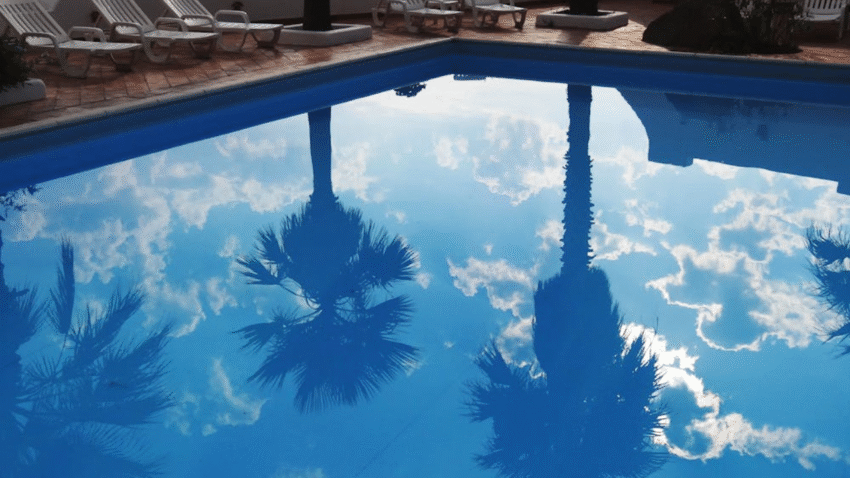Introduction
Tired of cloudy or murky pool water that ruins your swim? Learning how to maintain pool water clarity is key to keeping your backyard oasis sparkling, safe, and swim-ready. In this guide, you’ll discover a step-by-step approach to crystal-clear water by mastering filtration, chemical balance, and regular upkeep.
Why Maintaining Pool Water Clarity Matters
Clear pool water is more than just visually appealing—it’s a sign your pool is clean, balanced, and safe. Cloudy or discolored water often indicates poor sanitation, imbalanced chemicals, or an overworked filter system. By focusing on water clarity, you’ll enjoy:
- Healthier swimming conditions (fewer bacteria and contaminants)
- Longer equipment lifespan
- Lower chemical and cleaning costs
- A beautiful, inviting pool
Proper water clarity supports optimal pH balance, sanitizer effectiveness, and overall maintenance.
Step-by-Step Guide to Keeping Pool Water Crystal Clear
Step 1: Test and Balance Pool Chemicals Weekly
Use a reliable pool water testing kit or test strips to measure chlorine, pH, total alkalinity, and calcium hardness levels. Here’s what you’re aiming for:
- Chlorine: 1–3 ppm
- pH: 7.2–7.6
- Alkalinity: 80–120 ppm
- Calcium Hardness: 200–400 ppm
Adjust with the proper chemicals if levels are too high or too low.
💡 Tip: Test your pool in the early morning or evening for the most accurate results.
Step 2: Clean Your Filter System Regularly
Whether you use a cartridge, sand, or DE filter, keeping it clean ensures proper circulation and filtration. A clogged filter won’t catch fine debris and will reduce water clarity. Clean it every 4–6 weeks or as recommended by the manufacturer.
🧼 Related Tip: [Learn how to clean pool cartridge filters] for best results.
Step 3: Brush and Vacuum the Pool
Brushing the walls, floor, and steps removes algae, dirt, and biofilm that cloud your water. Follow up with manual or automatic vacuuming to collect loosened debris.
- Brush 2–3 times a week
- Vacuum at least once a week
⚠️ Caution: Don’t forget to clean behind ladders, pool lights, and steps—algae loves hidden spots.
Step 4: Skim the Surface Daily
Leaves, insects, and organic debris break down quickly and release contaminants into the water. Use a pool skimmer net daily to collect floating debris before it sinks or causes cloudy conditions.
💡 Tip: Invest in a floating skimmer for automatic daily maintenance.
Step 5: Shock Your Pool as Needed
Shocking means adding a large dose of chlorine to kill bacteria and oxidize contaminants. Shock your pool:
- After heavy use or a party
- After a rainstorm
- When water appears cloudy or smells like chlorine
Use a non-chlorine shock weekly or chlorine shock every 1–2 weeks depending on use.
Step 6: Maintain Proper Water Levels
Water that’s too low can damage the pump, while water that’s too high won’t skim properly. Keep your water level at the midpoint of the skimmer opening.
💡 Tip: After heavy rain, drain excess water using your pool pump’s “waste” setting if needed.
Step 7: Run the Pool Pump Daily
Run your filtration system long enough each day to cycle all the water through the filter—typically 8–12 hours daily depending on your pool size and climate.
⚙️ Tip: Hot climates or heavy pool use may require longer run times.
Common Mistakes to Avoid
1. Ignoring Small Cloudy Spots
Cloudy water often starts small. If left unchecked, it can escalate to full-blown algae or bacteria blooms.
✅ Check clarity daily and take action at the first sign of cloudiness.
2. Overloading with Chemicals
Too much chlorine or algaecide can actually reduce clarity by causing chemical imbalances.
✅ Always follow dosage instructions and test before adding more chemicals.
3. Not Brushing the Pool
Vacuuming alone doesn’t remove algae stuck to the walls and floor.
✅ Brush before vacuuming for better results.
4. Skipping Regular Filter Cleaning
A dirty filter can’t remove fine particles and will lead to murky water.
✅ Stick to a filter cleaning schedule based on usage.
5. Relying on Rainwater
Rain may seem like a free water source but can dilute pool chemicals and introduce debris.
✅ Test and rebalance water after every significant rainfall.
Extra Tips & Pool Hacks
- Use a clarifier weekly to bind tiny particles together for easier filtration.
- Try tennis balls in your skimmer basket—they absorb surface oils and sunscreen.
- Install a pool cover when the pool isn’t in use to reduce debris and evaporation.
- Keep landscaping trimmed back to minimize leaves, pollen, and dirt blowing into the water.
🧼 Related Tip: [Read our full guide on how to shock your pool properly] for more info on this critical clarity step.
Conclusion
Maintaining pool water clarity doesn’t have to be complicated. With regular testing, cleaning, and circulation, your pool will stay clear, sparkling, and ready for swimming anytime. Stay consistent, act fast when you notice changes, and enjoy the confidence of a perfectly maintained pool.
👉 Bookmark this guide so you can keep your water crystal clear all season long!
